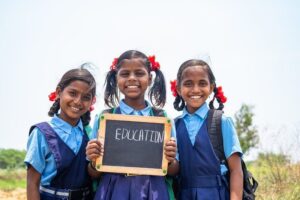By Akshika Jangid
In a nation where education is revered as a beacon of hope, the recent exam paper leaks cast a long shadow. It raises a critical question: where is the money allocated for education going and will the government increase the allocation for education further?
With the National Education Policy (NEP 2020) marking four years, India still allocates only about 3.5% of its GDP to education, far from the 6% recommended by the Kothari Commission in 1964. Education is a fundamental driver of economic growth, social equality, and personal empowerment. The World Bank estimates that a 1% increase in education spending can boost GDP by 0.5%. Yet, spending more money does not automatically translate into better outcomes.
As Mahatma Gandhi famously said, ‘Education is the greatest weapon which you can use to change the world.’ Investing in education is an investment in our nation’s human capital as well. It equips our youth with the skills and knowledge they need to thrive in the 21st century. There is a widespread belief that increasing emphasis on elementary and higher education—through more schools, more teachers, and more funding—will solve the challenges. But here’s the twist: while the popular belief is that “more” — more schools, more teachers, more funding — automatically means “better,” reality says otherwise. The real need is not merely “more” but smarter strategies that focus on identifying and addressing existing gaps in educational quality and access.
The Reality Gap
Laying down some recent facts, In 2022, ASER survey revealed that 57% of the kids in class 5 across the surveyed population did not know how to read the class 2 text. Now this is really a big difference and a startling one as it’s not just about reading and writing but the ability to learn and understand what is actually happening around us. There was another survey study carried out by ASER which surveyed 14-18 year old students which are 9th- 11th grade students. In that study they found that half the kids could not solve basic arithmetic problems.
Hence, we will find such failures of lack of student learning outcomes which stems from the systemic issues — teacher absenteeism, lack of skills provided or practical learning exposure, outdated pedagogy that in turn feeds into unemployment and income inequality.
Quantity vs Quality
Traditionally, the focus has been on Nehru’s emphasis on higher education, evident in the establishment of IITs and medical institutes. While investing in more educational institutions seems logical, the reality is that around ₹7,500 crore is spent on education, constituting 3% of GDP. Most of this budget goes toward staff salaries, infrastructure maintenance, and minimal student inputs. The real issue lies in prioritizing outputs over outcomes. This proves a crucial point: throwing more money at the system without reform will not improve education. We must rethink its design, need accountability, smarter allocation, and outcome-driven strategies.
So let’s talk about the per pupil expense (PPE), a crucial metric that measures how much the government spends on each student enrolled in government schools. This ratio between total government spending on education and PPE highlights the need for effective allocation of resources. The PPE has been fluctuating significantly over the years, often doubling or quadrupling without corresponding improvements in student learning outcomes. This indicates a systemic issue with the way money is being spent. We need to shift our focus from merely increasing the budget to ensuring that funds are used efficiently and effectively to achieve desired results.
To ensure accountability and transparency, we must implement robust monitoring mechanisms to track how education funds are being utilized at the ground level. This includes regular audits, performance evaluations, and feedback from teachers, students, and parents. Moreover, it’s essential to invest in teacher training programmes and development to equip teachers with the skills and knowledge needed to deliver real learning, not just rote instruction.
However, mere budgetary increases won’t suffice. We must also address the fundamental inequities within our education system. It’s unfair that government funds are disproportionately allocated to students who attend government schools, while those who choose to exit the system are left with limited resources. Moreover, public spending should be symmetric per child.
So now you would like to ask how can the spending be symmetric?
Bridging the public-private divide
In order to equalize the use of per pupil government funding, we propose a harmonious coexistence between public and private schools. Regardless of whether a student goes to government school or not, we can rethink what government school can do the best to retain students within the educational institution. By utilizing government schools as physical facilities for the mid-day meal program, we can ensure that all students within the public education system have access to nutritious meals during their lunch breaks and attend private schools, allowing them to access higher-quality teaching. Through this way, we are not changing any rules of competition and even the school teachers retain their jobs. Under such a model, funds are allocated to support a child’s education, not the institution.
Given the ongoing trend of parents transferring their children from government schools to private institutions, as evidenced by ASER data, it’s clear that significant reforms are necessary to address the underlying issues within the government school system. A fundamental principle of fairness dictates that public funds should not be withheld from students who have chosen to exit the government system. Such a practice is not only unjust but also counterproductive, as it fails to support the educational needs of a growing segment of the population that is underprivileged.
Empowering Parents as partners
The most overlooked stakeholder in a child’s education is often the one who cares the most — the parent. When parents are truly empowered, they are not just spectators; they become active partners in shaping their child’s learning journey. Yet too often, parents lack the tools, awareness, or confidence to fully engage with their children’s education.
By equipping them with the right resources, knowledge, and support systems, we can transform homes into powerful learning environments. Empowered parents can champion their children’s education, catch early signs of struggle, and work with schools to bridge learning gaps. In doing so, we not only reduce dropout rates but also nurture a culture where education is a shared family mission — and every child has someone fighting for their future.
The Way Forward
ASER’s large-scale surveys have laid bare the reality of both public and private schools — but knowing the problem is only the first step. True transformation will come only through collective and coordinated action by government, educators, parents, and civil society. Together, we can bridge the public–private divide, level the playing field, and empower the next generation — building an education system that is truly equitable, inclusive, and future-ready.
Yes, India must increase its education budget, but money alone is not the magic bullet. What matters more is how we spend it. The focus must shift from maintaining institutions to maximising student outcomes, from funding schools to funding children, and from chasing quantity to delivering uncompromising quality.
A bigger budget might ignite the spark — but only smarter spending will fuel the fire of real educational change. Because in education, it’s not just about counting the rupees — it’s about making every rupee count.







